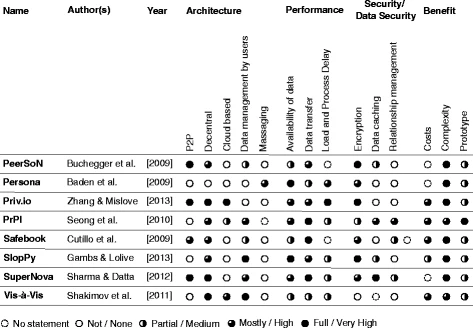Slope One with Privacy (SlopPy) Social Network
A Slope One with Privacy (SlopPy) Social Network is a Decentralized Online Social Network that is based on a Slope One algorithm and a randomized response technique.
- AKA: SlopPy.
- Context:
- It was first developed by Gambs & Lolive (2012) .
- It requires a SloPy Recommender System.
- It can include the following DOSN's services:
- Example(s):
- ...
- …
- Counter-Example(s):
- See: Randomized Response Technique (RRT), Weighted Slope One Algorithm, Recommendation System, Decentralized Network, Decentralized Computing System, Decentralized Application, Distributed Network, Decentralized Clinical Trial, Online Social Network, Deviation Matrix, Cardinality Matrix.
References
2017
- (Muller et al., 2017) ⇒ Andre Muller, Andre Ludwig, and Bogdan Franczyk (2017). "Data Security In Decentralized Cloud Systems – System Comparison, Requirements Analysis And Organizational Levels". In: SpringerOpen - Journal of Cloud Computing.
- QUOTE: The results of the comparison are summarized in Fig. 1. The solutions of the investigated concepts of PeerSoN (Buchegger et al., 2009), Priv.io (Zhang and Mislove, 2013), Safebook (Cutillo et al., 2011), and SuperNova (Sharma & Datta, 2012) are based on a peer-to-peer approach. The concepts PrPl (Seong et al., 2010), SlopPy (Gambs & Lolive, 2012), and Vis-à-Vis (Shakimov et al., 2011) are based on distributed applications and on server solutions as well as cloud solutions that are self-managed by the user. As a common ground of these concepts, all parties are expected to run and manage their own cloud system. The eight already mentioned systems will now be explained shortly and examined with regard to their currently unsolved problems.

|
2012
- (Gambs & Lolive, 2012) ⇒ Sebastien Gambs, and Julien Lolive (2012). "SlopPy: Slope One with Privacy". In: Data Privacy Management and Autonomous Spontaneous Security (pp. 104-117). Springer, Berlin, Heidelberg.
- QUOTE: In this section, we describe SlopPy (for Slope One with Privacy), a privacy-preserving version of Slope One in which a user never releases directly his personal information (i.e, his ratings)(...)
SlopPy architecture. Figure 1 illustrates the architecture of the SlopPy recommender system. More precisely in SlopPy, each user first perturbs locally his data (Step 1) by applying a Randomized Response Technique (RRT) before sending this information to the entity responsible for storing this information through an anonymous communication channel (Step 2). This entity is assumed to be semi-trusted, also sometimes called honest-but curious in the sense that it is assumed to follow the directives of the protocol (i.e., it will not for instance corrupt the perturbed ratings send by a user or try to influence the output of the recommendation algorithm) but nonetheless tries to extract as much information as it can from the data it receives. Out of the perturbed ratings, the semi-trusted entity constructs two matrices (i.e., the deviation matrix and the cardinality matrix) following the Weighted Slope One algorithm (Step 3). When a user needs a recommendation on a particular movie, the queries these matrices through a variant of a private information retrieval scheme[1] (Step 4) hiding the content of his query (i.e., the item he is interested in) to the semi-trusted entity. By combining the data retrieved (Step 5) with his true ratings (which once again are only stored on his machine), the user can then locally compute the output of the recommendation algorithm for this particular item (Step 6).
- QUOTE: In this section, we describe SlopPy (for Slope One with Privacy), a privacy-preserving version of Slope One in which a user never releases directly his personal information (i.e, his ratings)(...)

|
- ↑ Rafail Ostrovsky, and William E. Skeith III (2007). "A survey of single-database private information retrieval: Techniques and applications". In: Proceedings of the 10th International Conference on Practice and Theory in Public Key Cryptography (PKC’07).